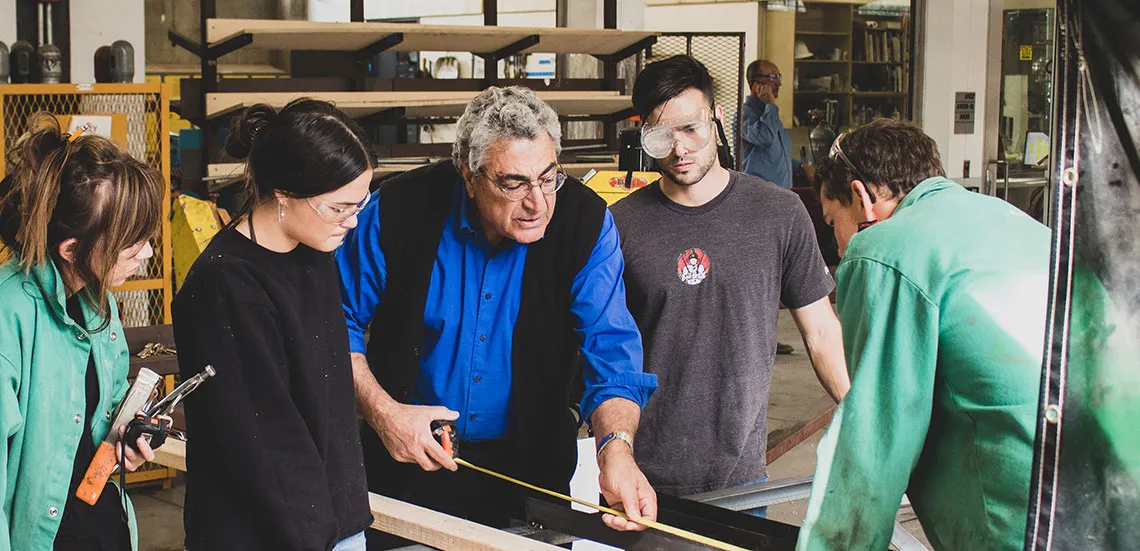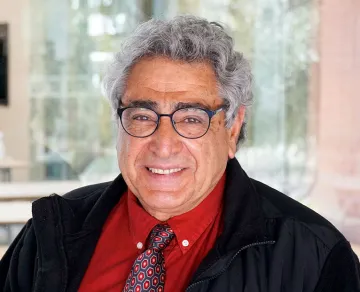Inspired Energies: Celebrating Nader Chalfoun, Professor Emeritus of Architecture and Environmental Sciences

Professor Nader Chalhoun with students in CAPLA's Materials Lab.
Thinking back on the 36 years that Nader Chalfoun taught at the University of Arizona before retiring at the end of the Spring 2020 semester as professor of architecture and environmental sciences, he’s most gratified by the progress made by students he’s worked with over the years.
“I’m so proud of the success they’ve found,” he says. “The students who have gone through this program now teach and lead energy and architecture programs throughout the world.”

Considering Chalfoun pioneered many of these advanced programs—including the House Energy Doctor Program he founded in 1984 and, later, the nation’s first LEED program for homes—you might think the technology itself would be his greatest satisfaction.
“Technology is essential,” he agrees, noting how architecture bridges design and building technology, “but I associate architecture first with research and science. nd once architecture students learn how to conduct research, they acquire an interdisciplinary foundation for design that sets them apart.”
Indeed, he recalls how representatives from major architectural and real estate development firms would contact him to inquire about his architecture master’s students, wanting to be first in line to hire them.
“I was keen to graduate the highest-caliber students to meet the demand for experts who could incorporate energy conservation, renewable energy and sustainability into building design and construction,” he says.
Developing in-demand skills is important, but for Chalfoun’s students, their success wasn’t just because of what they learned in a course. “Professor Chalfoun has been a father figure to many of us,” says Rachelle Hornby ’18 MS Arch. “He has sparked curiosities in us in order to help us blossom in our educational experiences. He has embraced us, loved us, nourished our souls and pushed us to be our absolute best.”
Like many of the graduate students he has taught, Chalfoun came to Tucson from another country to study architecture. Originally from Egypt, he received his undergraduate degree in architectural engineering from the University of Cairo and a diploma studying solar energy from St. Étiènne University in France. But he knew that the leading research on solar energy was taking place in the American Southwest, so he enrolled in the UArizona Master of Architecture program in 1983.
“I fell in love with Tucson from day one,” he says—and he hasn’t moved anywhere else since, though he and his family return to Egypt most summers, where he also manages an architecture and environmental design consultancy.
Egypt is also where Chalfoun cultured a different kind of energy: music. “I have many things I’m passionate about,” he says, “but the one thing I love besides teaching is music.” He began playing guitar and singing as a boy and played in several local rock and roll bands—Ram Jam, Les Petits Chats, The Tops, The Pharaohs. “I played with my band the last night before I came to the U.S.,” he recalls.
Though he took a year off from music in grad school, it wasn’t long before he was back at it in Tucson, even eventually forming a band with a former CAPLA dean and other faculty members: The Energy Band.
“Nader Chalfoun is a man of many talents,” says Robert Miller, director of the School of Architecture. “He has had a long and illustrious career at the University of Arizona and was a pioneer in what came to be known as sustainable design, developing innovative applied research like cool towers, working to advance energy standards in building codes and providing public outreach by testing residential and commercial structures for air infiltration and energy performance. He recruited hundreds of students to the university from around the world, students who became like family. Professor Chalfoun will be deeply missed.”
“I am overjoyed for Professor Chalfoun’s retirement,” says Hornby, “but I am saddened that future students will not have the pleasure of having him in their lives.”
We wish Nader Chalfoun all the best in his retirement. Even though his energies now turn elsewhere, Chalfoun will always be a part of the college and the many students he taught. After all, “CAPLA is in me,” he says. “And I am in CAPLA.”



